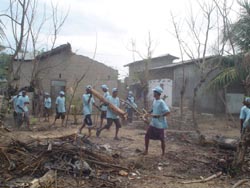You are here » Home » Telling Our Story
Success Story
Volunteers work together to help communities recover
Tsunami Response Unites Sri Lanka

| |
Photo: USAID/Julie Fossler
|
|
Youth volunteers aiding the tsunami
cleanup in Trincomalee establish
relationships across ethnic boundaries.
“This disaster has displaced
traditional ethnic divisions,”
said Wayne Brook, head of
USAID’s Office of Transition
Initiatives in Ampara.
|
Two days after two-thirds of Sri Lanka’s coastal villages were
ravaged by the tsunami, Sinhalese volunteers called USAID to
offer their help for relief efforts in the hardest-hit areas. The villages
in most need of aid were predominantly Tamil and Muslim—
Sinhalese adversaries in two decades of armed
conflict. A month later, hundreds of Sinhalese volunteers
continued to arrive, clearing destroyed houses,
felled trees and endless debris.
As the only international organization with a presence
in Ampara at the time of the tsunami, USAID is working
with Sri Lankans to respond—despite the fact that
several relief workers were themselves victims. The
worst-hit schools have been a priority for cleanup so
that communities can re-establish stability in the lives
of children traumatized by the tsunami. Sinhalese volunteers,
with the help of USAID translators, have also
offered to help Tamil residents clean up their homes.
“This disaster has displaced traditional ethnic divisions,”
said Wayne Brook, head of USAID’s Ampara Office of
Transition Initiatives. “Each of our ongoing conflict resolution
programs includes components encouraging people of different
ethnicities to come together for some purpose, which has manifested
itself in this spirit of volunteering.”
In the northeastern Trincomalee district, USAID is taking a
youth-oriented approach to the recovery, in an effort to
strengthen relationships across ethnic boundaries. Multi-ethnic
teams of 400–1,000 youth volunteers have been awarded
grants to obtain protective gear, clothing and emergency medical
supplies.
Immediately after the disaster, USAID provided emergency
food, shelter, water, sanitation and medical supplies. But now it
is helping Sri Lanka plan its long-term recovery, by establishing
cash-for-work programs to clean up debris and repair damaged
property. Small loans are helping people repair boats, reopen
shops and start new businesses. USAID is also working with
international and local organizations to provide psychological
and social support to help individuals, families and communities
cope with the trauma they experienced.
Print-friendly version of this page (75kb - PDF)
Click here for high-res photo
Back to Top ^ | 

